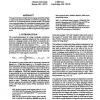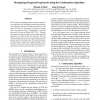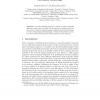2610 search results - page 57 / 522 » The Recognition Strategy Language |
LREC
2010
13 years 11 months ago
2010
The SignSpeak project will be the first step to approach sign language recognition and translation at a scientific level already reached in similar research fields such as automat...
NAACL
1994
13 years 11 months ago
1994
Thispaperintroduces a simple mixtare languagemodelthat attempts to capture long distance conslraints in a sentence orparagraph. The model is an m-component mixture of Irigram mode...
FGR
1998
IEEE
14 years 2 months ago
1998
IEEE
The recognition of human gestures in image sequences isan importantand challengingproblem that enables a host of human-computerinteractionapplications. This paper describes an inc...
WG
2004
Springer
14 years 3 months ago
2004
Springer
Let be the following strategy to construct a walk in a labeled digraph: at each vertex, we follow the unvisited arc of minimum label. In this work we study for which languages, app...
FLAIRS
2006
13 years 11 months ago
2006
This paper presents strategies and lessons learned from the use of natural language annotations to facilitate question answering in the START information access system.



